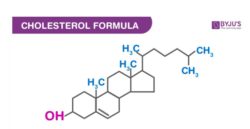Cholesterol is derived from the Ancient Greek word chole meaning bile, stereos meaning solid and -ol for alcohol. It is an organic compound and is a type of lipid as it is a sterol. It is also an important structural component of the animal cell membrane and can be biosynthesised by all animal cells.
It is also known as cholesterin and cholesteryl alcohol. The property value of hydrogen bond donor and hydrogen bond acceptor are 1 and 1 respectively and the rotatable bond count is 5.
Following is the table of formulas of cholesterol:
| Molecular formula | C27H46O |
| The Simplified molecular-input line-entry system (SMILES) | C[C@H](CCCC(C)(C) [C@H]1CC[C@@H]2[C@@] 1(CC[C@H]3[C@H]2CC =C4[C@@]3(CC[C@@H](C4)O)C)C |
Structure Of Cholesterol

As cholesterol is a cholestanoid with cholestane with a double bond at 5,6-position and a 3beta-hydroxy group. It plays the role of a human metabolite, mouse metabolite, an algal metabolite and a Daphnia galeata metabolite. It is a 3beta-sterol, a cholestanoid, a 3beta-hydroxy-delta(5)-steroid and a C27-steroid.
Properties Of Cholesterol
| IUPAC name | (3β)-cholest-5-en-3-ol |
| Molecular formula | C27H46O |
| Molecular mass | 386.664 g/mol |
| Melting point | 148 to 150℃ |
| Boiling point | 360℃ |
| Density | 1.052 g/cm3 |
| Solubility | Soluble in acetone, benzene, ether, hexane |
| Solubility in water | 1.8 mg/L at 30℃ |
| Appearance | White crystalline powder |
To learn more about Chemistry related concepts, stay tuned with BYJU’S.
Comments